100 Years from the founding of African national congress


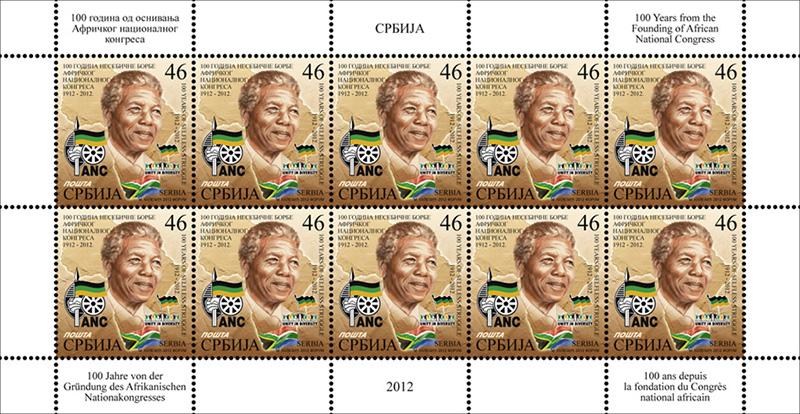

The African National Congress was founded in 1912. is the most important political party in the Republic of South Africa. It is not only the dominant political party but also liberation movement which has played a crucial role in the establishment of democracy in the Republic of South Africa, after decades of brutal apartheid regime.
“One hundred years of unselfish struggle” is the official slogan of the celebration of one century of existence of African National Congress, the most important political factor in South Africa’s achieving of liberty and justice and establishing of democratic state founded on truth, reconciliation and equality of the citizens, disregarding their race, religion or ethnic origin.
From 1991. until 1997, at the head of the African National Congress was Nelson Mandela, winner of the Nobel Peace Prize (1993), the first democraticly chosen president of the Republic of South Africa (1994), and honorary citizen of the city of Belgrade.
In the Republic of South Africa and African continent, as well as in the Republic of Serbia, the whole year of 2012. will be dedicated to the century of working of the oldest liberation movement of the African people.
Artistic realization of the stamp: MA Marina Kalezić, academic painter. Expert collaboration: Aleksandar Ristić, First Secretary, Department for Africa and the Middle East, Ministry of Foreign Affairs.
Lunar horoscope - year of dragon








Chinese astrology is based on the traditional astronomy and calendars. It also has a close relation with Chinese philosophy (theory of the three harmony, heaven, earth and earth) and principles: the wu xing teachings, yin and yang, five planets, the 10 Celestial stems, the 12 Earthly branches, the lunisolar calendar, etc.
The lunar calendar is based on cycles of the moon phase. Most lunar calendars are in fact lunisolar calendars. That is, months are kept on a lunar cycle, but then intercalary months are added to bring the lunar cycles into synhronisation with the solar year. Chinese, Hebrew, and Hindu calendars are lunisolar, as well as most calendar systems used in antiquity. Lunar calendars differ as to which day is the first day of the month. For some lunar calendars, such as the Chinese calendar, the first day of a month is the day when an astronomical new moon appears in a particular time zone.
The Chinese horoscope falls into the oldest known horoscopes. It consists of 12 signs of which each one rules over a lunar year. These Zodiac signs have the names of animals (Rat, Ox, Tiger, Rabbit, Dragon, Snake, Horse, Sheep, Monkey, Rooster, Dog and Wild Boar). In the Chinese horoscope, besides basic signs, very important are also elements: Wood, Metal, Water, Fire and Earth. Every person born in the year of the assigned animal is said to have personalities and traits resembling that animal.
According to the Chinese Zodiac, the year of 2012. is the Year of the Dragon, and occurs from January 23rd to February 9th, 2013. The dragon, creature of legends and myths, is the 5th sign of the Chinese Zodiac.
In the early China, power and emperor was represented by the celestial Dragon. At present the Dragon signifies happiness and success. People born in the Year of the Dragon are enterprising, self - assured, brave and passionate.
It can be expected that the 2012. Year of the Dragon would be a joyful one fulfilled with success.
Artistic realization of the stamp: Boban Savić, М.А., academic painter.
Art – Arhitecture

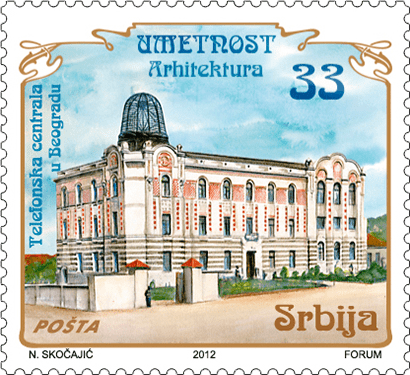



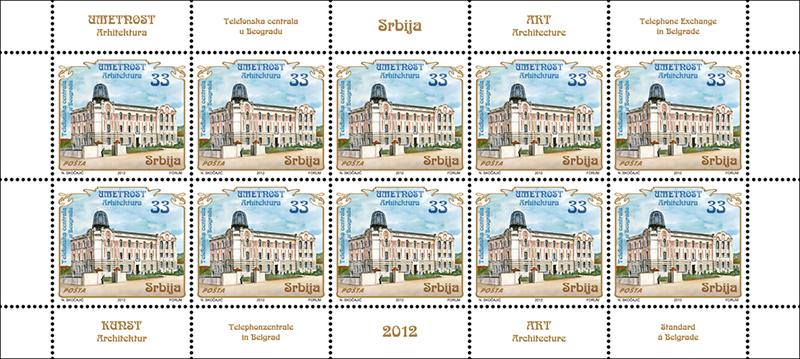






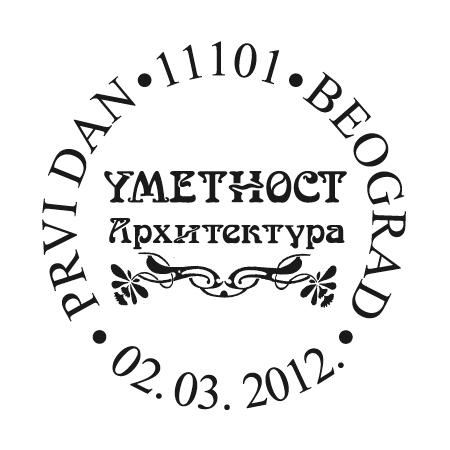
Department Store in Belgrade
The department store in Kralja Petra Street number 16, in Belgrade is pronouncly vertical, harmonious, and has beautiful proportions. It represents the most successful and most pure example of Secession architecture in Belgrade. It was built in 1907, in those days main trade street, according to the plans of architect Victor Azriel. It was built for Bencion Buli, famous banker and representative, as the first modern department store in Belgrade, completely different from traditional stores. The specific purpose of the building enabled the architect to treat the interiors and use modern constructions much more freely. This fairly small building has a cellar and four floors of which the ground floor, midfloor and first floor represent a unique selling space, and the highest floor is dedicated to the storage.
This department store was the first trade building in Belgrade, in which several floors were mutually connected and open. This open space was achieved with the use of columns, galleries, and an iron bridge that passed through the central space in the height of the first floor, lightened by the façade and rectangular lanterns from the flat roof. The highest floor is completely separated with an iron ceiling and dedicated to storage, and offices are in the back part, just behind the selling space. The architectural program of the department store is depicted with the Secession style façade. Done as a glass “wall-curtain” and held by an iron bar, the façade is located between two marble pillars with characteristic endings - decorative elements in the shape of prisms. White pillars on black polished granite bases, decorated in relief, with naturalistic female masks with undone hairs, from which slope down stylized geometrical strips. The arc ending of the façade, as well as the iron balcony fence, which, by its position, bisects the building into two parts, are done in moderate Secession style. Symmetrically set and with a trapezoid base, the portal with doorknobs in the shape of swans is located in the central part of the ground floor. This zoomorphological detail, along with anthropomorphic female masks, geometrical strips and interlaced floral elements represent the decorative repertoire of the department store. Thanks to the architecture of the store department, the city of Belgrade kept pace with the times. Its constructor introduced the Secession style in the architecture of the Serbian capital almost at the same time when it was up-to-date in other countries. By applying all elements of “Art Nouveau”, Victor Azriel drew up the plans for this, nowadays lonely architectural concept, which was declared cultural property in 1966.
Telephone Exchange Building in Belgrade
The beginning of the 20th century and the emergence of Secession marked for Serbia the start of national Romanticism, which clearly reflected in the field of construction. One of the structures that can be interpreted as a discovery of the desired Serbian Byzantine style was the main telephone exchange building in Kosovska Street.
The architectural design was made by the architect Branko Tanazević (1876-1945), the most prominent representative of the national style in Serbian architecture in the first half of the 19th century.
The construction of the building in the Kosovska Street started in 1908, and the telephone exchange started working in 1910.
The main façade faces the Parliament Park, and its dominant part is on the right side, next to the neighboring building. The parallel to this risalite (the dominant part), is the corner of the building with sets of three extremely large windows on each floor and a monumental fini-shing decoration developed in three mild arches, with a hollow dome typical for Secession. The national marking on the building are before all the decorative elements based on the Moravian School style. The building is characterized by strong coloristic accents. Namely, the neutral façade carries decorative elements made from bricks fired to a strong color.
The ground floor is dominated by two colored horizontal lines, while the first and the second floor are connected with vertical decorative elements. The building construction however, has marks of acade-mism. Since the number of offices did not satisfy the needs of the postal and telegraph service, the officials proposed an additional floor to be constructed in 1919. The building was finished in 1925 and has kept its shape until today.
Hotel „Moskva” in Belgrade
The Moskva Hotel was the first construction project that marked the future construction of the Terazije square. In the early 20th century, the Insurance Company ”Rossia“ from St. Petersburg, bought land at the corner of Kralja Milana (today Terazije square) and Balkanska Street, in order to build a facility for its company. In 1905. the Company announced the open competition for the construction of the building. The first prize and the right to realization, won the work of architect Viktor Kovačić from Zagreb. However, the management of the Company in St. Petersburg disagreed with the decision of the jury, and accepted the design of Jovan Ilkić, awarded the second prize. Architect Ilkić was invited to St. Petersburg, where the work on the design was continued in cooperation with Russian architects. The design was signed by the architect Pavel Karlovič Bergštreser, ”head-architect“ of the Insurance Company ”Rossia“. The Moskva Hotel was realized under the supervision of Jovan Ilkić. Freed of traditional compositional procedure, by the used type of decoration and by the use of new materials such as Swedish granite, reinforced concrete, faience, marble and ceramics, it is among the first examples in Serbian architecture on which was accepted the Secession style. Green ceramic tiles which made a special decorative colourful façade formwork, were designed in the famous factory of maiolica and ceramic ornaments ”Zolnaj“ from Pecs. Decorative motifs on the façade were made according to Ilkić’s design. Significant details of the hotel’s façade and its ornamental assemblage are represented by the sculpure ”Woman with Three Children“ as well as by ”Glorification of Russia“ allegorical relief representation of economic and naval forces of Russia, made in maiolica style. The Palace of the Insurance Company ”Rossia“ with a café and the Moskva Hotel, was opened by King Petar I Karađorđević on January 14, 1908.
Soon afterwards, the Hotel became the headquarters of the Journalists and Writers Association. In 1910, this was the place where the Olympic movement was founded in Serbia. In 1923, the first post office windows of the Postal Savings Bank were open here, and in the post-war years regular guests of the Hotel were, among others, Ivo Andrić and Vasko Popa. In the first 100 years of its existence, it had more than 36 million visitors among which Nikola Pašić, Albert Einstein, Jean - Paul Sartre, Alfred Hitchcock, Miloš Forman, Indira Ghandi, Luciano Pavarotti, Orson Welles, Ray Charles, Carl Lewis, Jack Nicholson and many others. By the middle of the 20th century, the building was declared cultural monument under state protection.
100 Years of the City Hall in Subotica
The City Hall is certainly the most important building in Subotica. It was built as a result of two hundred years of effort to transform a wild and unsuitable living environment into a milieu convenient not only for living, but also for a first-class spiritual, aesthetic and artistic experience. In that period, Subotica was part of the Austro - Hungarian Empire. Today’s City Hall is the third built on the same location. The first City Hall was built in 1751, the second between 1826. and 1828, and the plans for the third were made in 1896, but they were not realized.
In 1902, the ambitious Karolj Biro became mayor of Subotica. Some of the most important city buildings from the beginning of the 19th century were built under his supervision. An open competition for the construction of the City Hall was announced on August 30th 1906. One of the conditions of the competition related to the construction style which had to be baroque in the honour of the Habsburg Empress, Maria Theresa. The city enjoyed the free royal city status bestowed upon it by the Empress. The first prize at the competition won architects from Budapest, Marcel Komor and Deže Jakab, who went in front of the senate with the suggestion to build a City Hall in Secession style instead of baroque, which would reduce building expenses.
So, until June 1908, new plans were approved for the City Hall and its construction began. At the same time, in the Romanian town Targu Mures, a City Hall was being built in the new style, according to the plan of the same architects. Rough works were completed until 1910, but they needed two more years to complete the interior works designed by the hand of Deže Jakab. The then constructed building was 105,08 m long and 55,56 m wide, with the basic area of 5.838 m2 and 16.000 m2 of useful area. It was a modern building by its function, as well its equipment; it had plumbing, sewerage system, central heating and elevator, which led from the official entrance to the third floor.
The City Hall was finished in 1912. as an omen of the New Age, and administration house in the service of the citizens. Its rich Secessionist decoration, inspired by folklore motifs of embroidered parts of national costumes and architecture from Transilvania, on the façades, and especially in the interior, through symbolic reviews are presented characteristics of the whole those days way of life in Subotica.
Artistic realization of the stamp: Nadežda Skočajić, graduated graphic artist.
Expert collaboration: Major’s office in Subotica, Dr Viktorija Aladžić, Ljudevit Vujković Lamić i Augustin Juriga.
125 years of the National theatre in Niš




After the liberation of Niš from the Turks, theatre art lovers founded the Travelling Theatre „Sinđelić” troupe which had its first premiere on 11th March 1887. under the name of „Serbian Hajduks“, by Jovan Sterija Popović, in the elite café „Europe“. Mihajlo Dimić was the first manager of the theatre. On January the first 1939, was performed the first play called „Building of Ravanica Monastery or Endowment of Emperor Lazar“, by author Milorad Popović šapčanin, and director Dragoslav Kandić. An important place in the development of theatrical art belongs to Milorad Petrović, Stevan Sremac, Stevan Nikšić Lala, Henrih Liler, Đorđe - Đoka Protić and špira Kalik.
The golden creative period of the National Theatre is connected to Ljubiša Ružić (1954 - 1964), its manager, and Bora Trajković, manager’s assistant, acting manager secretary.
The theatre’s stage gave birth to the first modern Serbian actors, directors, scenographers, costume designers... Most performances had the following plays: „Ivko’s Feast“, author S. Sremac, director and dramaturge Dušan Životić (1957), „Zona Zamfirova“, author S. Sremac, director Ljuba Milošević (1976), „Jovča“, author B. Stanković, director Jovan Putnik (1975), „Autobiography“, author B. Nušić, director Aleksandar - Saša Glovacki...
For 125 years, the number of awards is impressing: for acting achievements, we single out two from „Sterija pozorje“ given to Dragan Žikić and Živko Vukojević; at the Yugoslav Theatre Festival, in Užice - Verica Jovanović („Ardalion”); at the Comedy Days in Jagodina („Turkey - cock”): Vasja Stanković, Đorđe Vukotić, Sanja Krstović. More than 200 awards were won At the Gatherings of Professional Theatres of Serbia „Joakim Vujić“. We won 8 awards (in 2008. and 2011.) at the International Festival „Joakim Fest“ in Kragujevac. Audiences in Poland, Austria, Bulgaria, Hungary, Russia, Albania, as well as in all former Yugoslavia republics saw our plays. Biljana Vujović is at present at the head of the institution. She has established the „Glum Bal” Festival, the First Balkan Theatre Festival dedicated to the best theatrical and acting achievements.
We last 125 years but each day we feel younger!
Daniela Trajković Ivanović,
Head of Management and Sale Unit. Artistic realization of the stamp: Marina Kalezić М.А., academic painter.
Easter






Easter Sunday is the date of the annual celebration of Christ’s resurrection. The Orthodox Church celebrates the Easter on the basis of the Julian calendar. The date is not fixed, but denotes the same season of the year and the same relationship to the preceding astronomical full moon that occurred at the time of His resurrection in 30 A.D. Easter is one of the most important Christian holidays. This is a day of eternal joy, the day when Christ, the Son of God, conquered the death. By the act of resurrection Jesus Christ proved his divine power and opened the gate of eternal life, joy and happiness that we can find in our faith. On Easter Sunday morning the church bells toll, and the people, together with their priest, go round the church. After the third round they stand in front of the church doors. The priest carries the cross, candle and the censer and chants the Easter hymn. The doors open and they enter the church where liturgy continues. When it ends, people greet each other with the words: “The Christ has resurrected”, and “Indeed he has”. There are many customs connected with Easter Sunday, and certainly one of them that children like best, is colouring and offering of eggs. The first egg is coloured red and in many parts of our country it is called “The house keeper” and is kept for the whole year, until the next Easter.
On stamps and envelope are used museum exhibits from the Serbian Orthodox Eparchy Museum, Budim, Szentendre. The basic fund of the collection in Szentendre gives us a complete summary of the development of art in the Eparchy, and at the same time shows the fundamental characteristics of Orthodox Church Art in the Danube region and wider, particularly during the 18th. century.
Motif on the stamp face value 22,00 RSD: Resurrection of Christ, unknown workshop, detail of the Gospel filigree, XVIII century, (enamel, silver). Motif on the stamp face value 46,00 RSD: Resurrection of Christ, the upper part of the throne’s cross, unknown workshop, XIX century, (enamel, silver).
Motif on the envelope: Secret supper, Mihailo Živković, detail of the ancient iconostasis of the Serbian church in Balasadarmat, 1815, (wood, oil, 58 x 43 cm).
Graphic realization of the stamps: Nadežda Skočajić, graduated graphic artist. Expert collaboration: Kosta Vuković, Head of the Collection of the Serbian Orthodox Eparchy Museum, Budim, Szentendre.
Science






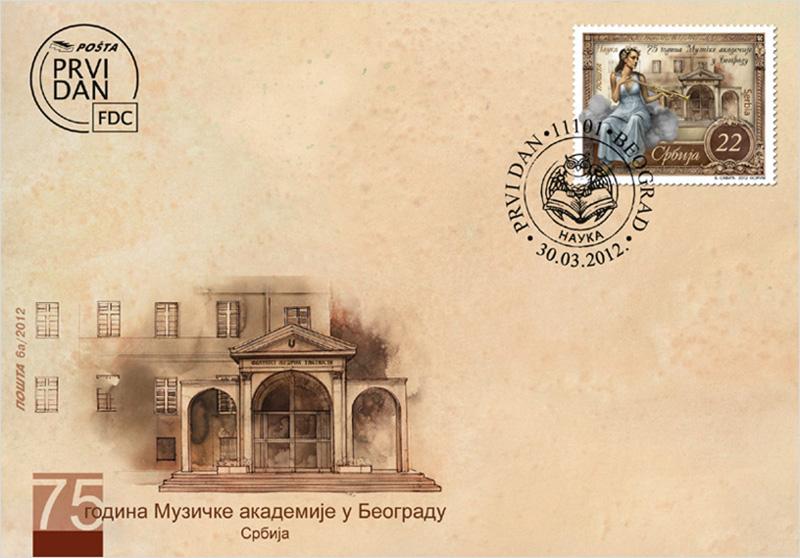

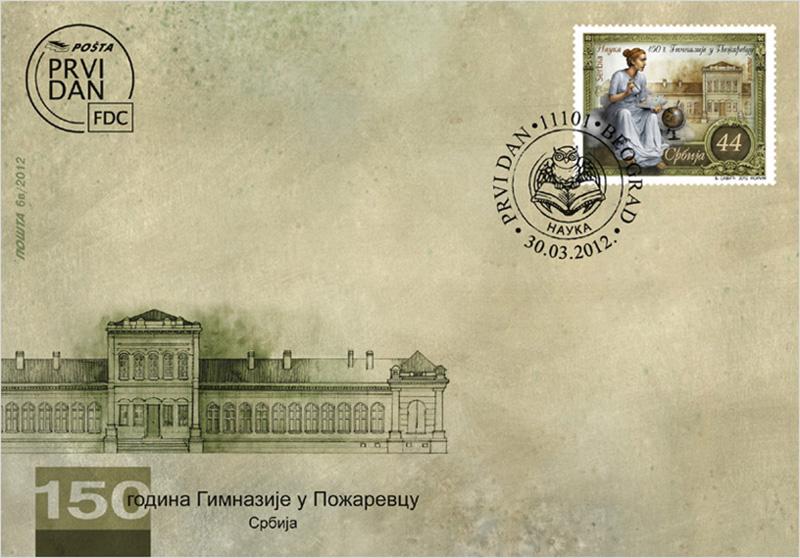

75 Years of the Academy of Music in Belgrade
Belgrade Music Academy, the nowadays Faculty of Music Art was founded 75 years ago, by the decree of the Ministry of Education of the prewar Yugoslavia.
The Faculty of Music Art is the first artistic highschool institution in our milieu, which with its multi-decades work and results represents a real leader in the field of musical creativity, interpretation and education, and a desirable and inspiring artistic partner to many prominent institutions from the whole world.
The guiding thought of the first professors and Faculty’s founders was to form artists and pedagogues who will, through their concert and teaching activities, create a specific artistic consciousness and by it transform and ennoble the wider social community. This artistic process of development is being continued even today with great enthusiasm by new generations of students and professors. A huge progress - artistic music became a structural element of the cultural expression of our milieu, famous art music festivals in our country already celebrate multiple decade jubilees, symphony orchestras, numerous chamber and vocal-instrumental ensembles, as well as almost everyday soloist recitals gather a big part of the population with their high-quality and interesting contents. The universality of the language of music, which is especially being cherished on all educational levels at the Faculty of Music Art - Basic, Master and Doctor’s academic studies, which results in the creative curiosity of the students and professors who freely undertake artistic and scientific researches. By their exceptional personal engagements and permanent following of world innovations professors of the Faculty of Music Art encourage those cognitive processes. In addition, international artistic and scientific successes achieved by professors and students of the Faculty of Music Art are the best reference and strong stimulus for the future.
Artistic realization of the stamps: Boban Savić, М.А, academic painter.
Expert collaboration: Faculty of Music Art in Belgrade.
75 Years of the Academy of Fine Arts in Belgrade
The Academy of Fine Arts in Belgrade was founded in 1937, and in 1973. was renamed the Faculty of Fine Arts. In seventyfive years of its existence, 2.887 students graduated from the Faculty and 1.146 completed post-graduate studies. Since its founding until today, 138 prominent artists from Serbia and wider Balkan region have been teaching at the Faculty.
The Faculty’s founders and first professors, Petar Dobrović, Milo Milunović and Toma Rosandić, were educated abroad (Paris, Vienna, Florence, Munich, Budapest), and used their experience to fashion the Belgrade Academy after similar world institutions of that type. Although the Faculty belongs to more recent institutions of higher learning of this type in Europe, it has acquired a high reputation through its activity. In fact, the Faculty of Fine Arts continues the artistic schooling in Serbia, which acquired an organized form in the second half of the nineteenth century. At the beginning of the 21st century, the Faculty of Fine Arts continues its transformation and keeps the shape of a dynamic and modern educational and art institution.
Artistic realization of the stamps: Boban Savić, МА academic painter.
Expert collaboration: Milutin Dragojlović, Dean, Full Professor, Faculty of Fine Arts in Belgrade.
150 Years of the Gymnasium in Požarevac
Požarevac Grammar School was founded by a decree of Prince Mihailo Obrenović on September 24th 1862. as Požarevac Middle School..
In the following years it has changed names several times:
On foundation it was named Požarevac Middle School. On December 6th 1989. it was renamed Prince Mihailo Grammar School In Požarevac. by a decree. It was made into full grammar school that year. In 1904. it was renamed Grammar School in Požarevac. In 1951/52. it was renamed Higher Grammar School.In 1959. it was renamed Grammar School Grammar School „Jovan Šerbanović“.In 1978. it was transformed into School Centre for Vocational Education „Jovan Šerbanović“. In 1989. it was renamed Grammar School „Jovan Šerbanović“.Since May 22nd 2001. the school has been known as Požarevac Grammar School.
The most important awards:
On occasion of its centenary, in 1962, the school was awarded October Award of Požarevac Municipality.In 1966, by the President of the SFRY, Josip Broz Tito, the school was honoured by a Medal for People’s Merit with a Gold Star.For its contribution to the cultural development in the Republic of Serbia, in 1992, the school was awarded Vuk’s Award.
The most important dates in the rich history of the school:
On September 15th 1890. Student Society Razvitak. It initiated the magazine Naša riznica, followed by a magazine for literature, science and culture Razvitak , which still exists today. During 1895. the Museum of the Grammar School was founded, which served as the kernel for the Požarevac City Museum. During 150 years, our students have achieved great success on all levels of competition in numerous subjects and in their further education.
Today, Požarevac Grammar School cherishes its traditions but also keeps up to date with educational trends. It actively participates in numerous educational and cultural activities which will hopefully become the school’s tradition in the future.
Artistic realization of the stamps: Boban Savić, М.А, academic painter.
Expert collaboration: Danijela Žukovski, Director of Gymnasium in Požarevac.
Joint issue Serbia – Slovakia



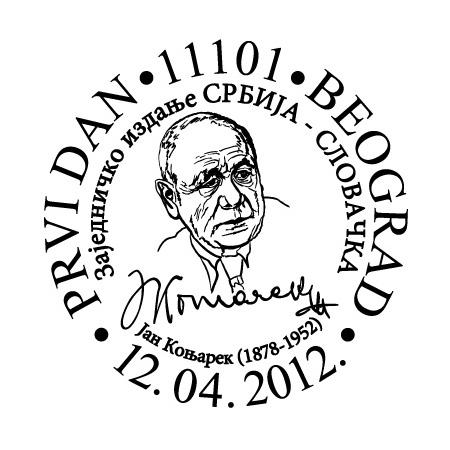
Jan Koniarek (1878-1952)
Through the joint realization of postage stamp issues, postal administrations implement and strengthen cooperation and communication, as well as the exchange of valuable experiences. Through postage stamps, countries easily communicate, no matter how far away geographically they may be and which language they speak. This time, the sculptor, Jan Koniarek, who impressed his art ideas on the development of the sculpture in Serbia while teaching in secondary schools, represents the connection between Serbia and Slovakia.
One of the most important Slovak artists, the leading figure in the Modern Art Sculpture, the sculptor Jan Koniarek (30.01.1878 Voderady - 04.05.1952 Trnava) through his artistic expression laid foundations of the contemporary Slovak sculpture. In Budapest, he was the student of Alojz Strobl, and graduated in the class of professor fon Riman (1900 - 1904), in Munich.
After graduation, from 1906. until the beginning of World War I in 1914, he worked in Serbia as creative education pedagogue in secondary schools in Čačak and Belgrade. During World War I he was mobilized and sent to the front, where he fought side by side with Serbian soldiers. After the war, he returned to Slovakia.
Jan Koniarek’s artistic expression represents the height of the sculpture in Slovakia at the beginning of the XX century, and the basis of the modern Slovak sculpture. Koniarek’s work stretches thematically into two directions: monuments dedicated to national activists and monuments dedicated to those who died in World War I. The author’s best achievement relating war topics is represented in the monument Fallen for Trnava, erected in 1929. At the very end of World War II, Koniarek also created two works which expressed the dramatic times - relief Voice of the War and the sculpture Voice of the Uprising, with which he completed his war theme creations. From monuments dedicated to people’s tribunes and soldiers, the most important for Slovakia are surely those dedicated to M.R. štefanek, from 1926, and to the poet Jan Holly, from 1929. One period of his creation, Koniarek also dedicated to intimate fine plastic art, in which one can discern the influence of Secession and Impressionism. From this phase, we can single out most important works as: Girl in the shower, Avalanche, Drinking Man, and portraits Mrs. Sesler, Boy’s head... In Koniarek’s work, the ideas of freedom, discerned in the creations belonging to the fifties of the 19. century, reached the top.
Motif on the stamp: Head of St. John Baptist (bronze, 1906), National Museum in Belgrade; motif on the envelope: Head of Professor Milorad Pavlović - Krpa (coated gypsum, 1910), National Museum in Belgrade.
Graphic realization of the stamp: Nadežda Skočajić, graduated graphic artist.
25th Belgrade marathon





This year’s 25th jubilee Belgrade Marathon will be held on 21st April 2012.
According to numerous official and unofficial polls, it is the most important sports manifestation in our country. There is just a few international events which are so successful and last so long. Already for 25 years, every spring, the Belgrade Marathon is promoting sports, but also economic, cultural and turistic potentials of Belgrade and Serbia.
The most cheerful Belgrade river, with 20.000 participants from more than 30 world countries, who run the half marathon, marathon and the 5km Fun Run - draw significant attention from the national and international media - is the major sports and promotional event traditionally held in our capital.
The Belgrade Marathon wouldn’t be what it is without the excellent support and cooperation with the Belgrade City Council, Ministry of Youth and Sport, Athletic Federation of Serbia, Tourist Organization of Belgrade, Tourist Organization of Serbia, Ministry of Health, and numerous partners, sponzors and friends, among which, from the very beginning until today, is also the Public Enterprise of PTT Communications „Srbija“.
Artistic realization of the stamp: Radomir Bojanić М.А., academic painter.
Fauna - Reptiles




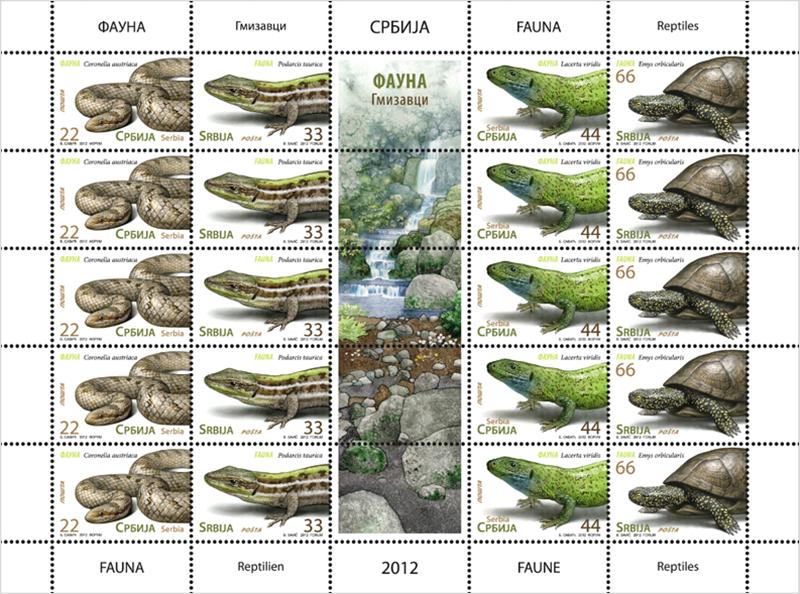


Reptiles (lat. Reptilia from reptilis - the one which crawls) played an extremely important role in the evolution of the animal world, because they represented the first group of vertebrates that completely went ashore. This was enabled by the development of the egg’s membrane and eggshell, which protected them from drying out. Their body is protected with horn scales and / or plaques, that protect them from loosing liquids, and they breathe solely via lungs. The fertilization is internal and most reptiles are oviparous (lay eggs), although a large number is also vivipary (live birth). The ability of regenaration is well developed and they are very resistant animals except to low temperatures. They can go a very long time without food; some snakes, for example, for more than one year. They are among the most long-lived animals on our planet. The most known extant groups of reptiles are: turtles, lizards, snakes, crocodilians, alligators and gavials.
Smooth snake - Coronella austriaca is a relatively small snake, not bigger than 80cm, with a very short head, round pupils and smooth skales. It has a brown / reddish brown or gray colouring, with dark square spots on the back. It can be found in dry habitats, but in Southern parts of Serbia it also inhabits more humid and relatively colder regions, on higher altitudes. It feeds primarily on lizards, rarely on small mammals.
Steppe lizard - Podarcis taurica can grow up to the size of 24cm, of which two thirds make up the tail. Its back is green, with two bright and fine lines on both sides with dark marble spots between them. It inhabits dry, mostly plain habitats of open type in Southwest, South, Southeast and Eastern Serbia and Vojvodina.
European green lizard - Lacerta Viridis is a large lizard distributed across Europe. It reaches more than 35cm in length. The tail can be up to twice the length of the body. Males have a uniform green colouring pronounced upon its back and females may be brownish or green brownish. Males have a characteristic turquoise blue colouring of the neck, which is very pronounced during mating. It is widely spread in Serbia. It mostly feeds on invertebrates, but also bird eggs, fledgling and sometimes fruits.
European pond turtle - Emys orbicularis is the most widespread freshwater species in Europe. It can grow up to the size of 30cm. Its shell is black with bright radial, in most cases yellowish broken lines that spread from the centre towards the periphery of the bony plaques. In Serbia it is mostly a depression species, but it can also be found in suitable habitats up to 1000m above sea level. This species is grasping and mostly feeds on water invertebrates, amphibians, fishes, plants, but also dead animals. Life span is 40 years.
Artistic realization of the stamps: Boban Savić, М.А, academic painter.
Expert collaboration: Ana Paunović, DSc, Curator Herpetologist, Natural History Museum, Belgrade.
Evropa - Visit Serbia
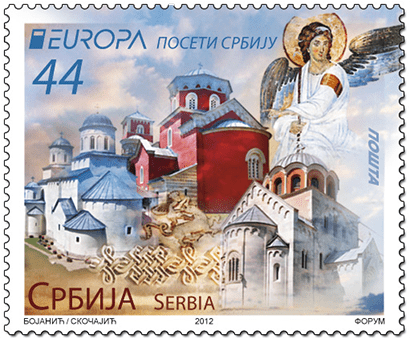





Interesting and exciting, Serbia is a country of undiscovered attractions and vividness, a concoction of traditional and modern:
Its capital city, Belgrade, is located on the confluence of the Sava river into the Danube. It lives around-the-clock, has wild and unique nightlife; tells to everybody about its rich history, pointing out to the Kalemegdan Fortress. The northern part of the country, Vojvodina, consists of the National park Fruška Gora, on the slopes of which stand 17 monasteries from the period XV to XVIII centuries, the numerous farmsteads offering healthy domestic food, wine cellars, and the international music festival EXIT, which takes place in Novi Sad every summer, on the Petrovaradin Fortress, gathering together over a half million of young people from around the world. The river Danube, union of adventure and culture, the National park of Djerdap, numerous cycling tracks, cruising, remnants of ancient civilizations Vinča and Lepenski Vir, the Roman Viminacium, one of the most significant military camps of that time. The hot South, city of Niš, known as a birthplace of Roman emperor Konstantin; lively music, spicy food, rugs from Pirot, peppers, hard cheese, the best Serbian barbeque. The brisk air of Mt. Stara planina and skiing sports, hiking; sights of intact nature... The central part of Serbia, Šumadija region, cultural and historical complex at Oplenac, the Kings’ valley and the coronation monastery of Žiča from the XII century, and Studenica monastery which is under UNESCO protection. The Western Serbia, measureless mountains, lakes, ideal spots for sports activities in untouched nature, Zlatibor, Tara National Park. The rivers like Drina, Uvac, Lim and Ibar offer rafting and mountaineering. The legendary trumpet player’s gathering in Guča, which each year draws more than half a million visitors from all over the world. The ride on the Šargan osmica train from 1925, Ethno village Sirogojno, Drvengrad, built by famous film director Emir Kusturica. Numerous spas once frequented by Roman emperors, and nowadays by businessmen and top athletes, present ideal places for relaxation. Numerous rural households will make you feel the warmth of the Serbian hospitality and introduce you to the old crafts, dishes and handicrafts. The Kopaonik mountain, the ski centre, bicycling, orienteering, hiking.
Wherever you go you will experience the tradition and spirit through various manifestations which take place throughout the year - the Homolje motifs in Kučevo, Mowing on Rajac mountain, Shepherd Days in Kosjerić, Vrnjačka banja Carnival and Grapes Gathering represent just some of them.
Tourist Organization of Serbia
Artistic realization of the stamps: Radomir Bojanić, academic painter and Nadežda Skočajić, graduated graphic artist.
European nature protection






Forest Nature Reserves
The first protected natural properties in our country - forest nature reserves are particularly valuable and preserved forests which make up the rich genetical archive of Serbia. Presented reserves mark the 50 years jubilee of protection and good governance practice, which led to the preservation of the woody species fund and entire biodiversity. These woody species represent the national and world natural heritage due to their ecological characteristics and rarity.
The Special Nature Reserve "Jarešnik" is located in the southeastern part of Serbia in Pčinja district. It is the only site of the Crimean Pine - Pinus nigra spp. pallasiana (Lamb) Holmb, and the only reserve of pure Black Pine Forest of primeval type in Serbia. The Crimean Pine (Pinus nigra Arn. Var. pallasiana) is occurring in the Crimea, Asia Minor, Greece, Bulgaria, Macedonia, and is recorded in Serbia on the south slopes of the mountain Crnook near Bosilegrad. It is a tree of coastal areas with low demands related to soil moisture. It can grow up to 30 m, and the age of the oldest trees is around 250 years.
Special Nature Reserve "Jasenova glava" is located in the region of Boljevac municipality and is a part of South Kučaj Forest Complex. The basic value of the reserve is the Yew (Taxus baccata) which, together with the Beech, represent the building species of this relict community. The reserve’s value is completed with the presence of endemorelict Mountain Maple (Acer heldreichii). The Yew (Taxus baccata) is an evergreen tree, 20 metres tall. It is a tertiary relict and natural rarity. Because of its importance, occurring and endangered level, it is a strictly protected species listed in the Red Data List of Flora in Serbia. The Mountain Maple (Acer heldreichii) is a tertiary relict and endemic to the Balkan Peninsula. It grows up to 20 m, on an altitude from 1.200 to 1.500 m, usually as a scarce accompanying species in forest communities. Due to its rarity, it is a strictly protected species. The Beech (Fagus moesiaca) is the most spread and main woody species in Serbia. It builds pure communities and forms the largest woody mass of our forests. The Beech areal covers the hills and mountains of Central, Western and South Eastern Europe. In Serbia, the Beech is spread in all altitudes. In reserves, it can graw up to 40 m, while it can reach over 1 m in diameter.
Artistic realization of the stamps: MA Marina Kalezić, academic painter.
Expert collaboration: Nataša Panić, Head of Educational-Issuing Activities Group, Institute for Nature Conservation of Serbia, Dr. Dragana Ostojić, Institute for Nature Conservation of Serbia.
175th Anniversary of the Construction of the Cathedral of St. Michael the Archangel in Belgrade


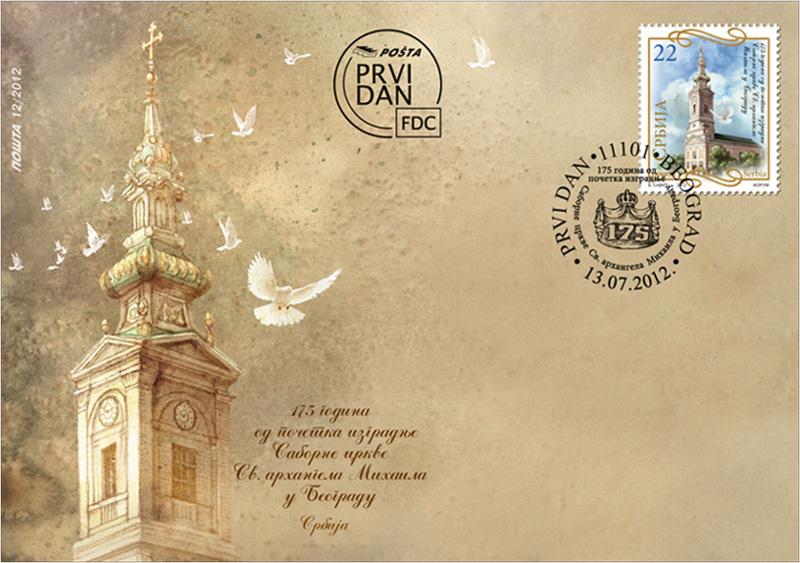


The Cathedral Church in Belgrade is dedicated to St. Michael the Archangel. It is located on the corner of the streets Prince Sima Marković and King Peter I, in the old part of town (the Varoš; Gate) and in the vicinity of the confluence of the Sava and Danube rivers.
It was built from 1837. to 1849. under the seniority of the Metropolitan of Belgrade, Petar Jovanović. The head architect was Adam Friedrich Kwerfeld, from Pančevo. This one-nave building was made of bricks and lime mortar on the old location of the XVI century church. In architectural terms, it was built in the style of eclecticism; a baroque bell tower above the porch on the west side dominates the classical style building. The complete interior decoration of the Cathedral (the wood-carved construction of the iconostasis, choirs, pulpits and thrones), according to the designs of the sculptor, Dimitrije Petrović, was accomplished by Dimitrije himself (works on the iconostasis) and Georgije Dević (choirs, pulpits and thrones). The icons on the iconostasis and the monumental compositions on the walls and barrel vaults of the Cathedral are works belonging to the painter Dimitrije Avramović, distinguished representative of the Serbian painting from the XIX century, formed under the influence of the Academy of Fine Arts Vienna. The wood-carved and painting works were done from 1841. to 1845.
An important reconstruction of the Cathedral’s facade and roof was done in the second decade of the XX century. Extensive works on conservation and restoration were carried out twice: from 1883-1884 and from 1993-1996. In 2003, three big icons from the western facade, painted with oil paint on copper base (1885/86) were replaced with Venetian glass mosaics with the same iconographic representations.
The Cathedral Church of St. Michael the Archangel in Belgrade was the center of many important events. Dositej Obradović (1742-1811) and Vuk Karadžić (1787-1864), eminent representatives of the Serbian culture were buried in the churchyard, in front of the main portal. Two reliquaries with the relics of Prince Stefan Štiljanović (1543) and Prince Lazar Hrebeljanović (1389) are inside the Cathedral, in front of the iconostasis. The icon with the relics of St. John of Shanghai and San Francisco (1996) is near the choir. Serbian princes, Miloš (1780-1860) and Mihailo (1823-1868) Obrenović are buried in the crypt of the Cathedral. Four First Hierarchs of the Serbian Orthodox Church: Serbian Patriarch Gavrilo (Dožić), тVikentije (Prodanov), Serbian Metropolitan Mihailo (Jovanović) and Serbian Metropolitan Inokentije (Pavlović) also rest in the Cathedral Church in Belgrade.
Artistic realization of the stamp: Boban Savić, М.А., academic painter.
Expert collaboration: Radmila Petronijević, custodian at the Serbian Orthodox Church Museum, Belgrade.
London 2012 Olympic games
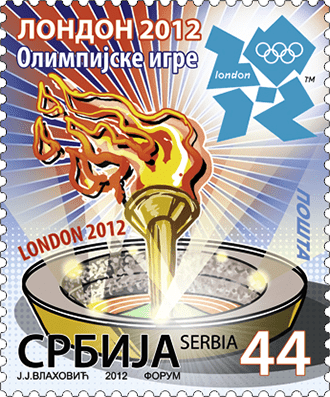





From a modest event at its beginning, the Olympic Games turned into a multi-sport, extraordinary and a mega event that, aside its unparalleled influence on athletes and sport, has had an unambiguous impact on cultural, technological, financial, urban and development of civilization in accordance with the principles of sustainable development.
Olympic Games are an event to participate in, an event to be seen, and an event with a multiple social and economic influence, for the organizers as well as those that prepare to participate in it. Benefits from the London Games will be reaped by the societal development in Great Britain, but also by the systems of sport and the Olympic movement of Serbia.
By participating in the Games in London, NOC Serbia celebrates 100 years since the first participation in the Olympic Games, 102 years since the foundation of the Committee, wishing that Serbia wins its 100th Olympic medal.
Serbia will be represented by more than 110 athletes competing in 15 sports in London, 4 teams in 3 team sports and over 60 athletes in 12 individual sports. Apart from the athletes, NOC Serbia’s delegation will include more than 70 sport experts.
A large number of referees and delegates in sports will take part compete in these Games, also in sports in which our athletes will not be taking part in, so that Serbia will, in fact, participate in total of 18 out of 28 sports of the Games of the 30th Olympiad.
Artistic realization of the stamps: Jakša Vlahović, academic graphic artist. Expert collaboration: Olympic Committee of Serbia.
Great authors of Serbian literature


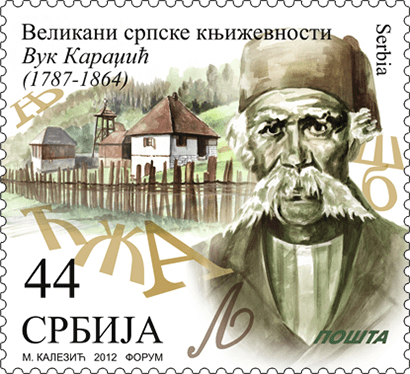



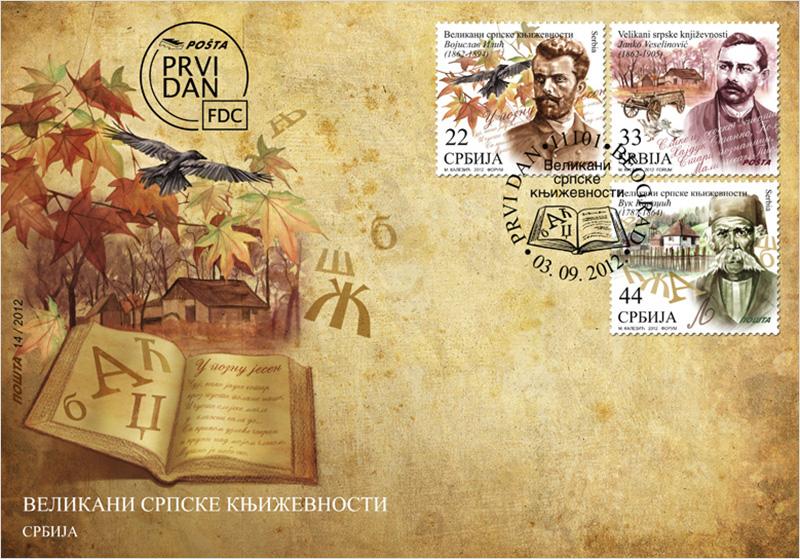

150 Years since the Birth of Vojislav Ilić
Vojislav Ilić (14th April 1862, Belgrade - 21st January 1894, Belgrade) Serbian poet who participated as a volunteer in the Bulgarian war in 1885, and then often changed appointments (corrector at the State Printing House, teacher in the Serbian school in Turnu Severin, scribe at the Ministry of Internal Affairs, Vice-Consul in Priština). He published three collections of poems (1887, 1889, 1892), and a large number of poems in various magazines. In Serbian poetry, Ilić made a decisive break with romanticism and opened the way in which poetry became the most important for itself, and for its own artistic being. His best-known poems: Angel of Peace, Autumn, In Late Autumn, On Vardar, Confession, Homeland, St. Sava, Winter Morning, On the Drina River, Winter Idyll.
150 Years since the Birth of Janko Veselinović
Janko Veselinović (13th May 1862, Crnobarski Farm - 26th June 1905, Glogovac, Mačva) With less than 18 years he became teacher, then mayor of Koceljeva municipality, and then assistant to the editor of Serbian newspaper, Milovan Glišić. He was also corrector at the State Printing House, National Theatre playwright, founder and editor of the magazine "Zvezda", editor of magazines "Pobratim", "Dnevni list". As a storyteller, novelist and playwright, for criticizing the government, Janko has repeatedly been in jail. He wrote over 30 books, including the famous Images of Rural Life, Wild Flowers and Hajduk Stanko.
225 Years since the Birth of Vuk Karadžić
Vuk Stefanović Karadžić (6th November 1787, Tršić - 7th February 1864, Vienna) Serbian philologist and reformer of Serbian language and Cyrillic alphabet (worked on the national language grammar), campaigner for the introduction of the vernacular in Serbian literature, writer of the first dictionary of Serbian language, collector of folk songs. Vuk’s reforms introduced phonetic spelling in Serbian language, which suppressed the church slavonic language. He believed that every phone should have only one letter. His greatest works include A Simple Little Slaveno-Serbian Songbook, Grammar of the Serbian Language (the first grammar of the Serbian language written in the vernacular with applied Adelung’s principle: Write as you speak and read as it is written - 1814), Serbian Book of Folksongs (1915), Serbian Dictionary (1818), National Serbian Proverbs (1836), the translation of the New Testament (1847).
Artistic realization of the stamps: MA Marina Kalezić, academic painter.Museum Exibits
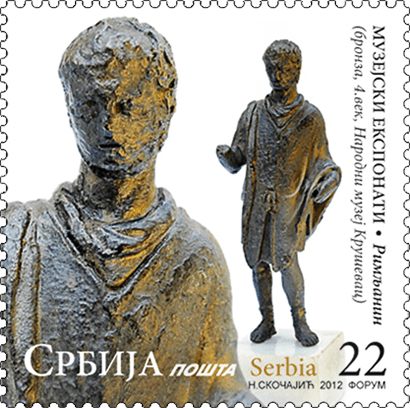





National Museum of Kruševac
The National Museum of Kruševac was founded on 19th December 1951. During six decades of its existence, it has been developed into a museum which treasures more than twenty-three thousand exhibits, gathered in seven collections: archaeology, history, numismatics, nature, ethnology, cultural history and fine arts. The Museum encompasses five buildings: the main building in the Lazar City, Memorial Complex Slobodište, Art Gallery, Old Menzulana (horse-exchange post) and The Simić House.
The main building of the Museum was erected in 1863, as the second facility ever in Serbia constructed as a Gymnasium building. The annex was added in 1908, and it has been a museum since 1964. The museum reconstruction and adaptation were completed in 2011 and 2012.
The bronze statuette of a Roman was found during archaeological research of the Lazar City. The statuette represents a young Roman dressed in toga, holding a spear in his right arm, and a scroll or a money bag in the left. The exhibit comes from the fourth century A.D.
During the conservation of the church of the Holy Ghost in Stalać City, a golden coin was discovered in the church foundation – a solidus of Constantine VII and Roman I. The coin was forged in Constantinople and represents one of the most important numismatic findings, witnessing the rise of cash influx to Serbia during the first half of the tenth century A.D.
A parade officer sabre belonged to the infantry second lieutenant Dragobrat Ž. Petrović (1909-1931) from Kruševac. Upon formation of Kingdom of Serbs, Croats and Slovenes, all the officers received the sabres with ornate knuckleguard and the basket decorated with the coat of arms of the newly-formed country. The name of the supplier "OFFICERS COOPERATIVE" is engraved on the blade, incorporating the Kingdom coat of arms. The exhibit comes from the legacy of the academician Vladan Đorđević, and makes a part of the cultural history collection.
The academician Vladan Đorđević has also donated to the Kruševac Museum a pair of silver officer shoulder marks which once belonged to his grandfather, a cavalry major Živojin M. Petrović (1880-1914). The exhibit is kept within the cultural history collection.
Motifs on the stamps: Stamp face value 22,00 RSD - statuette of a Roman, bronze, 4. century A.D.; motif on the vignette Byzantine gold coin, the first half of the 10th century A.D. Stamp face value 55,00 RSD - A parade officer sabre, the firs half of the 20th century A.D.
Graphic realization of the stamps: Nadežda Skočajić, graduated graphic artist.
Expert collaboration: The National Museum of Kruševac.
Joy of Europe


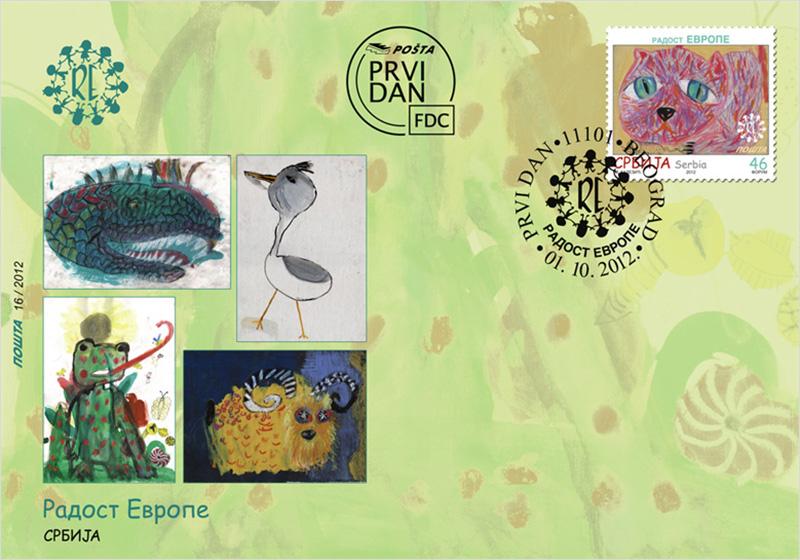

Gathering of children "Joy of Europe"; each year, from distant 1969, brings together children of Europe from 7 to 15 years of age who promote friendship, as a symbol of children’s unity, through different activities and also present exchange of different cultures. Authentic children’s creativity, expressed in direct contact with the citizens of Belgrade, each October (from 1st till 6th), opens the door to the better mutual understanding and better understanding of children’s world in general.
Motive on the stamp: Darja Celišćeva, 7 years old, Painting studio of Children’s cultural centre Belgrade.
Motive on vignette: Tara Đukić, 10 years old, Painting studio of Children’s cultural centre Belgrade.
Motives on the envelope: Andrea Tadić, 9 years old, Đorđe Rašić, 9 years old, Darja Celišćeva, 7 years old, Milica Tadić, 5 years old.
Expert assistance: Katarina Bulajić Pavlović and Goran Simić, Children’s cultural centre Belgrade Painting studio Lidija Seničar, editor of international art competition "Joy of Europe".
Graphic realization of the stamp: MA Marina Kalezić academic painter.
100th Anniversary of the battle of Kumanovo






The First Balkan War (1912-1913) is regarded as the most significant event of the new Serbian history. After several centuries, Serbia finally managed to liberate the old Serbia and the enslaved Serbian people of that time, and it regained its old state and spiritual seats such as Ras, Priština, Peć, Prizren and Skopje. Serbia managed to liberate from Turks the regions that were once densely populated and in which more than 1,300 Serbian churches and monasteries were located. Among them are: Peć Patriarchate, Visoki Dečani, Gračanica, Banjska, Mother of God Ljeviška, St. Archangels near Prizren, Mileševa, Sopoćani... Many of those monasteries and churches were devastated and turned into mosques, as was the case with Mother of God Ljeviška and Banjska.
The liberation of the Old Serbia in 1912 created preconditions for the new epoch in the political, economic, social and cultural development of these regions. It was a rare case in the Serbian history that some event, like it was the First Balkan War, gathered all the layers of the Serbian society together and gave birth to such unanimity in all the Serbian regions.
Motif on the stamp face value 22,00 RSD: portraits of general Radomir Putnik and Stepa Stepanović, colonel Živojin Mišić and regent Aleksandar Karađorđević; motif on stamp face value 50,00 RSD: Revenge of Kosovo (oil, 1913.), Paja Jovanović; motif on the vignette of the sheet face value 50,00 RSD: Kumanovo (drawing), Paja Jovanović; motif on the envelope: Kumanovo Battle (pastel, 1912.), Paja Jovanović.
Artistic realization of the stamp face value 22,00 RSD: M.A. Boban Savić, academic painter; graphic realization of the stamp face value 50,00 RSD: Nadežda Skočajić, academic painter-graphic artist.
Expert collaboration: Serbian Academy of Science and Art (SASA), Historical Museum of Serbia, Military Museum and Museum of the Belgrade City.
Stamp Day





75 Anniversary of the First World Philatelic Exhibition
First earthly philatelic exhibition (ZEFIB) was held in Belgrade from 12 to 29 September 1937 in the organization of Yugoslav philatelic union, which had at that time 26 members (companies) with 1150 registered philatelists.
The exhibition was held in the building of the new University (Philology faculty today) on the King’s square number 3 (Student’s square today), while the grand opening was held at the big hall of the old University (Captain Miša’s building) with the great number of guests, ministers, ambassadors and king’s emissary. 150 exhibitors participated in the exhibition, of that 70 from Yugoslavia and 80 from abroad: Austria, Belgium, Bulgaria, Denmark, Egypt, Lithuania, Luxemburg, Hungary, Germany, Poland, USA, France, Holland, Czechoslovakia and Switzerland, which made this exhibition international. Pursuant to the Exhibition Regulations, it was allowed to exhibit: "state issued postage stamps of all kind, units, imprints, documents from pre-philatelic period, stamps of local and private post offices, telegraphic and railway stamps, drawings, essays, proofs, counterfeits, fantasy stamps, literature, philatelic kit and other objects related to philately". At the end of the exhibition gold, silver and bronze medals were awarded, and within the exhibition the exchange of stamps was organized according to the special Regulations.
Expert collaboration: Jovan Ristić.
Artistic realization of the stamp: Radomir Bojanić, academic painter and Nadežda Skočajić, graduated graphic artist.
Christmas






Christmas is one of the most important and one of the most joyous Christian holidays, that is celebrated both by the Orthodox and Catholic believers. The difference is only in the date of the celebration; the Orthodox celebrates in on January 7th, and the Catholic on December 25th, but its message remains the same – the message of peace and love.
We celebrate Christmas for three days. It is primarily family holiday, and the customs in connection with Christmas are numerous. On the day before Christmas and Christmas Eve, the yule log is being brought into house, cresset lit and hay with hidden candies, prunes, walnuts, sugar and coins, spread all over the house. The hay is a symbol of the manger in which Christ was born. The yule log represents longevity and substance of Christianity, as well as of the warmth of the love Christ brought to us when he was born and arrived to the Earth. On the very day of the Christmas, early in the morning the church bells of all Orthodox temples are ringing, announcing the nativity of Christ. People go to church to attend Christmas liturgy and they all greet each other by "Christ has been born" and "Indeed he has".
Motif on the stamp face value 22,00 RSD: Nativity of Christ, icon from the iconostas of the upper church in Sremski Karlovci dedicated to the Presentation of the Holy Mother of God, the work of iconostasis Dimitrije Bačević from 1760 to 1761.
Motif on the stamp face value 46,00 RSD: Nativity of Christ, icon from the iconostas of the Lower Church in Sremski Karlovci dedicated to Holy Apostles Peter and Paul; the work of iconostasis Dimitrije Bratoglić from 1828 to1831.
Motif on the envelope: Nativity of Christ, icon from the iconostas of the Orthodox Cathedral in Sremski Karlovci dedicated to Saint Nicholas, the work of iconostasis Teodor Kračun and Jacob Orfelin from 1780 to 1781.цркве у Сремским Карловцима посвећене светом Николи; иконостас рад Теодора Крачуна и Јакова Орфелина из 1780–1781. године.
Graphic realization of the stamps: Nadežda Skočajić, graduated graphic artist.
Expert collaboration: Serbian Ortodox Eparchy of Srem in Sremski Karlovci.
100 years of Serbian Military air force




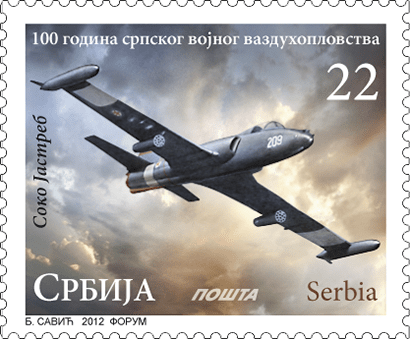





At the beginning of the twentieth century, while the balloons are largely used for military purposes and while first airplanes are flying over the skies of Europe, Serbia has got its war wings. The need to be in step with the time, current trends, new scientific and technological achievements and vision of our government and military leaders enabled Serbia in 1912, just 9 years after the first flight of the Wright brothers, to form the Air Force Command, based in Niš. Serbia was also among the first of countries that have recognized the importance of airspace and aircrafts to conduct the war and introduced the air force into its military units.
It has been 100 years of creation and development of the Serbian Military Air Force, the century of the heroic life of the airmen in the fight for freedom of the people and the homeland. Its history, interwoven with development periods and historical temptations, was related to events that have also affected our people and our country. Since the Balkan wars, through the First and Second World War, post-war time, bombing in 1999 and continuing to this day, generations of pilots, air defenders, technicians and specialists of different aviation profiles have given their youth, knowledge, enthusiasm and most valuable - their lives in the rich history of aviation. Their heroic deeds are never-ending inspiration and an example for present and future generations of pilots how to defend the honour of the profession and how to love and defend their homeland.
Today, the Serbian Military Air Force is organized on the model of the world’s leading air forces. At airports in Serbia there is still a smell of kerosene and aircraft noise. This represents a great hope for a better tomorrow, especially if you have a vision of the future, and Serbian military airmen clearly have it.
Artistic realization of the stamps: Boban Savić, М.А, academic painter.
Expert cooperation: Serbian Ministry of Defence, Command of Air Force and Air Defence of the Army of Serbia.